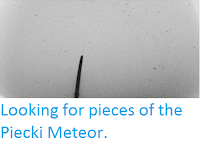The
Eta Aquarid Meteor Shower will peak before dawn on Friday 5 and Saturday 6
May 2017, with up to 45 meteors per hour at it's peak, radiating from
the constellation of Aquarius. The radiant point of this shower does not spend long above the
horizon in the Northern Hemisphere at this time of year, but is often a
good display in the Southern Hemisphere. The
Eta Aquarids are potentially visible between 19 April and 28 May, but
are extremely hard to spot away from the peak of activity, which this
year falls shortly before the Full Moon on Wednesday 10 May; however the Moon will be setting shortly after midnight, so there should still be some good opportunities for meteor spotting (the Moon sets at the same time no matter where you are on Earth, as it's rising and setting time is caused by its position relative to the Sun).
The radiant point for the 2017 Eta Aquarid meteors. The Leisurely Scientist.
The
meteor shower is caused by the Earth passing through the trail of
Halley's Comet, where it encounters thousands of tiny dust particles
shed from the comet as its icy surface is melted (strictly sublimated)
by the heat of the Sun. Halley's Comet only visits the inner Solar
System every 75 years (most recently in 1986 and next in 2061), but the
trail of particles shed by it forms a constant flow, which the Earth
crosses twice each year; in May when it causes the Eta Aquarid Meteor
Shower and in October when it causes the Orionid Meteor Shower.
See also...
Follow Sciency Thoughts on Facebook.







